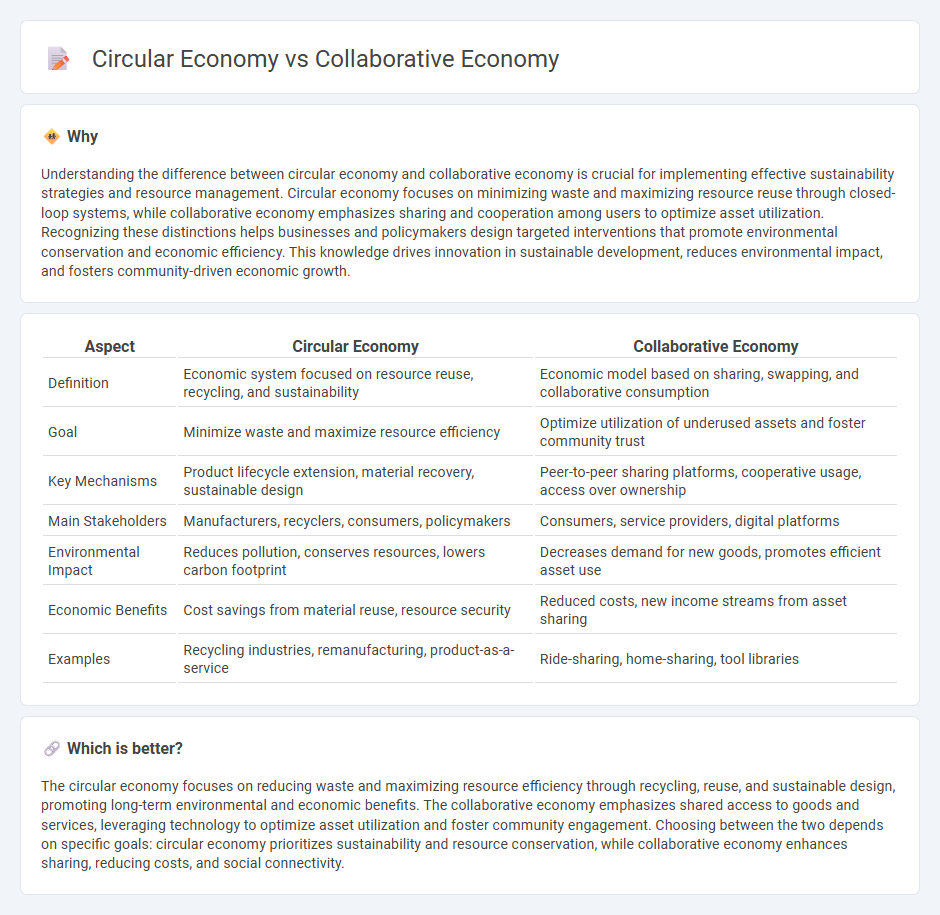
The circular economy focuses on minimizing waste and maximizing resource efficiency by promoting reuse, recycling, and sustainable product design. The collaborative economy emphasizes shared access to goods and services, leveraging digital platforms to connect users and reduce individual consumption. Discover how these innovative economic models are reshaping sustainability and business strategies worldwide.
Why it is important
Understanding the difference between circular economy and collaborative economy is crucial for implementing effective sustainability strategies and resource management. Circular economy focuses on minimizing waste and maximizing resource reuse through closed-loop systems, while collaborative economy emphasizes sharing and cooperation among users to optimize asset utilization. Recognizing these distinctions helps businesses and policymakers design targeted interventions that promote environmental conservation and economic efficiency. This knowledge drives innovation in sustainable development, reduces environmental impact, and fosters community-driven economic growth.
Comparison Table
| Aspect | Circular Economy | Collaborative Economy |
|---|---|---|
| Definition | Economic system focused on resource reuse, recycling, and sustainability | Economic model based on sharing, swapping, and collaborative consumption |
| Goal | Minimize waste and maximize resource efficiency | Optimize utilization of underused assets and foster community trust |
| Key Mechanisms | Product lifecycle extension, material recovery, sustainable design | Peer-to-peer sharing platforms, cooperative usage, access over ownership |
| Main Stakeholders | Manufacturers, recyclers, consumers, policymakers | Consumers, service providers, digital platforms |
| Environmental Impact | Reduces pollution, conserves resources, lowers carbon footprint | Decreases demand for new goods, promotes efficient asset use |
| Economic Benefits | Cost savings from material reuse, resource security | Reduced costs, new income streams from asset sharing |
| Examples | Recycling industries, remanufacturing, product-as-a-service | Ride-sharing, home-sharing, tool libraries |
Which is better?
The circular economy focuses on reducing waste and maximizing resource efficiency through recycling, reuse, and sustainable design, promoting long-term environmental and economic benefits. The collaborative economy emphasizes shared access to goods and services, leveraging technology to optimize asset utilization and foster community engagement. Choosing between the two depends on specific goals: circular economy prioritizes sustainability and resource conservation, while collaborative economy enhances sharing, reducing costs, and social connectivity.
Connection
Circular economy and collaborative economy are interconnected through their shared focus on maximizing resource efficiency and minimizing waste by promoting the reuse, sharing, and recycling of goods. Both models emphasize sustainable consumption patterns by encouraging community engagement and peer-to-peer exchanges, reducing the demand for new products and materials. This synergy enhances economic resilience by fostering sustainable business practices and reducing environmental impacts.
Key Terms
Collaborative economy:
The collaborative economy leverages shared access to goods and services through digital platforms, fostering peer-to-peer exchanges that optimize resource utilization and reduce costs. This model enhances economic efficiency by promoting asset sharing, crowd-based services, and community-driven consumption, contrasting with the circular economy's focus on material reuse and waste reduction. Explore the dynamics and benefits of the collaborative economy to understand its transformative impact on modern business practices.
Peer-to-peer sharing
The collaborative economy emphasizes peer-to-peer sharing platforms where individuals exchange goods and services directly, maximizing resource utilization and community engagement. In contrast, the circular economy focuses on reducing waste by designing products for reuse, repair, and recycling within closed-loop systems. Explore how these models intersect and diverge in creating sustainable economic practices.
Access over ownership
The collaborative economy emphasizes shared access to goods and services, reducing individual ownership by enabling peer-to-peer exchanges and resource pooling. In contrast, the circular economy prioritizes resource efficiency and waste minimization through reuse, repair, and recycling within a closed-loop system. Explore how both models transform consumer behavior and drive sustainable economic growth.
Source and External Links
The collaborative economy: What is it and how does it help us? - The collaborative economy is an economic model where consumers use technology to provide, buy, sell, share, or rent goods and services, fostering new business models and benefiting both consumers and the planet.
Collaborative Economy: Market Design and Basic Regulatory Principles - This model offers economic opportunities for individuals to trade underutilized assets efficiently through digital platforms, with significant growth potential and the need for supportive regulation.
What is the collaborative economy and how can it help us? - The collaborative economy involves sharing goods or services for agreed compensation and includes types like collaborative consumption, production, finance (crowdfunding), and open knowledge sharing.
 dowidth.com
dowidth.com